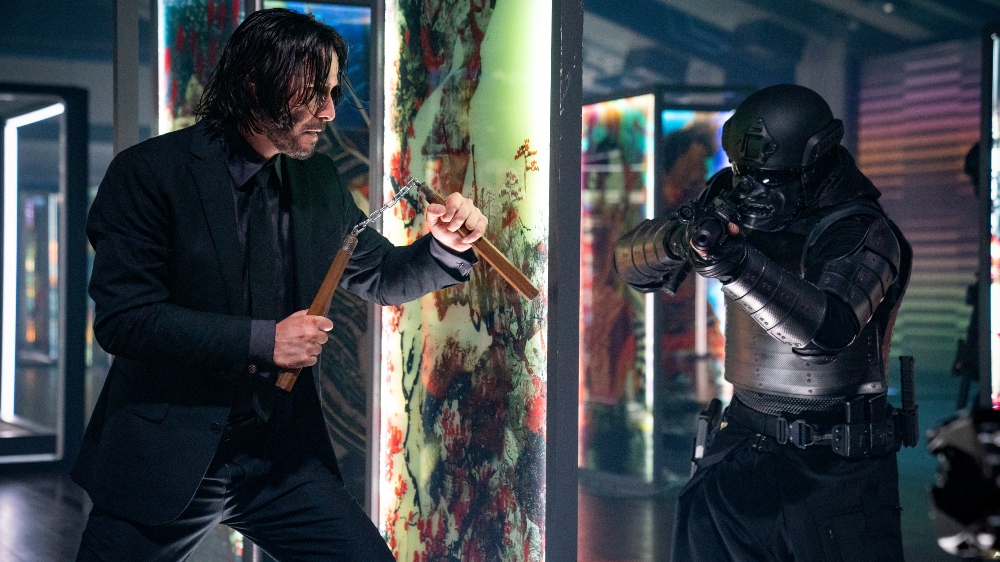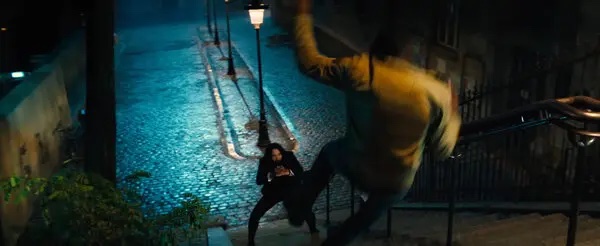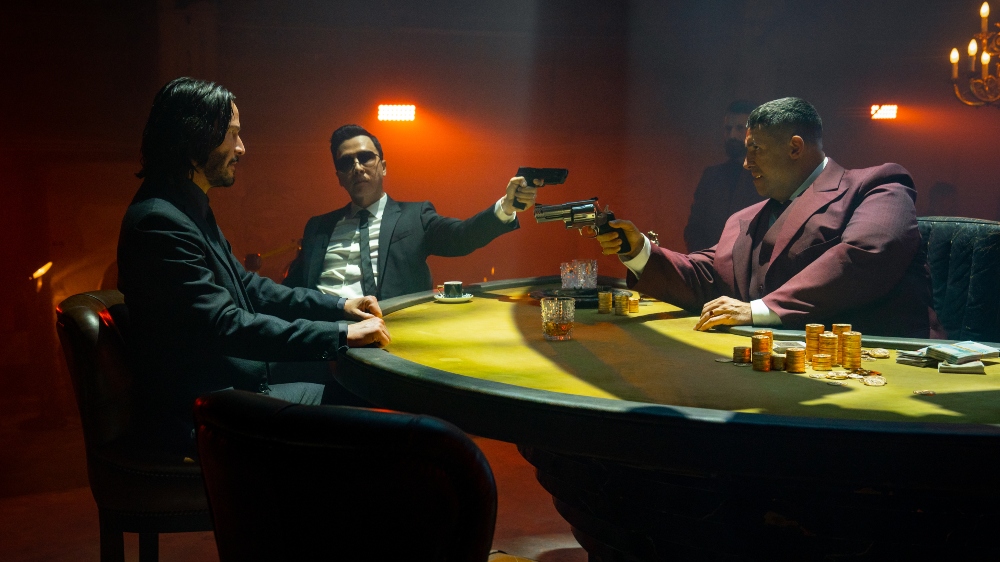
In light of last year’s smash hit John Wick: Chapter 4 recently taking home an Astra Award for Best Stunts, we had the opportunity to speak with the fourquel’s stunt coordinator Scott Rogers. A veteran of everything from True Lies to the Bourne franchise, Rogers has brought a flair for practical stunts to the world of Wick.
Since director Chad Stahelski is a renowned stuntman in his own right, one would imagine the folks he puts in place to supervise the stunt work on his own films would be of a very high caliber. As you’ll learn in our interview, Stahelski has known Rogers for decades, and he talks about the ways he fills in the gaps of the director’s own particular set of skills to create singular set pieces with real impact.
Below the Line: The thing about John Wick 4 is that any of the many set pieces in this almost 3-hour movie would be the climax of a normal action film. That said, what is the one sequence or stunt you’re the most proud of?
Scott Rogers: I’m most proud of the car stuff. In the John Wick world, I don’t do fight stuff. That’s really Chad and his fight team. I kind of oversee it, but I’m really more responsible for the traditional stunt stuff like in John Wick 3 with the horse and motorcycles.
In Chapter 4, it was anytime he falls or the car sequence. I’m really proud of the car sequence because it’s something we built to fit… it’s a great car sequence, and we wanted a great car sequence, but we wanted it to fit in the John Wick world. Editorially, the way it’s cut, the way it’s shot… We wanted it to feel like it belonged there; it’s not a Bourne car chase in a John Wick movie. I’m very, very happy with the way it turned out.
BTL: I have to ask about the mechanics of that stairway fall towards the end. Was it done with trickery? Was there padding that was erased? How do you pull something like that off safely?
Scott Rogers: I have a background with the Top Shot, which is an automated camera on wires. I’d worked with this flying camera team to create the camera move and then figure out how to do it with the stunt guy. We went for four takes, two of the takes I think he got hung up. He’s such an amazing stunt man, Vincent Bouillon. When we shot it you’re just like, “Oh, my God.” He’s wearing padding. You can’t pad all the stairs and stair falls, oddly, aren’t as bad as they seem. As opposed to like, falling… because each stair’s only six or nine inches, so you’re not falling three feet to the ground or 10 feet to the ground. You’re only kicking off down each step.
You just got to protect your head from hitting things. It was probably that day, because we did a bunch of the falls, and then we actually did the one where he gets thrown into the post and spins around the post, which is a brutal stunt. Probably the most brutal day of stunts I’ve ever seen anyone do, but he was well paid for it. He would have kept going if we asked him to.

BTL: Being a legendary former stuntman, what does Chad intrinsically understand about your job that other directors, even major directors, often don’t?
Scott Rogers: He understands the value of prep. A lot more time and money is spent in prep, which actually translates to somewhat of a savings because it makes you more efficient on the days of shooting and you get a higher quality. The need for that is it not only makes the stuff better, but when you have a 50-some-year-old actor that’s doing these long takes the team around him has to… If he screws up, that’s on him, but you don’t want to be the guy that makes him do another 45-second take or minute-and-a-half fight because you screwed up at your end, you know?
Because of Chad you get a lot more prep, a lot more effort and time and money. You’re always looking for ways of doing things for real, not like in a Marvel world. The interesting current state of the film industry with the strikes and all the other shifts going on and the lack of success that the Marvel movies are having, but the massive success that the John Wicks are having is telling everyone that people want to believe it. They don’t want to look at something and say, “Was that real?” They want to know that it was there. “Holy shit, that was brutal.” There’s still VFX involved, but not solely. It takes what we do.
BTL: It doesn’t matter that no human being could survive all those things, but just in the moment we know that there’s some realism to that action beat.
Scott Rogers: Yeah, it’s like when he falls out of a four story building and bounces off a van, and you’re just like, “Oh, crap.” And then he lays there and goes, “Uggh,” and he gets up. It’s just fun.
BTL: You were both the stunt coordinator and second unit director. When you were operating this other unit, presumably an action unit, how much leeway did Chad give you, or is he very specific about what he wants from the shots?
Scott Rogers: I was the stunt coordinator on John Wick 3 with Darrin Prescott directing, and we put together the horse scene and the motorcycle scene. We’ve spent a lot of time, obviously, getting to that point with Chad, but he gives us quite a bit of leeway. There’s a lot of trust there, we’ve known each other for 30 years. It’s not like we just met at the beginning of the movie. He knows my background, he knows what I excel at is very different than what he excels at: I don’t do fights.
I’ve spent the majority of my career in this other world and he spent the majority of his career… not that he’s not capable of doing the cars and all the other stuff, but he’s definitely poured a lot more time and effort into fighting, which is the meat and potatoes of a John Wick movie.

BTL: You’re a veteran of two John Wick movies as well as Matrix Resurrections and Constantine. I remember reading an interview with the late Anthony Bourdain about how even though he had all these decadent meals on his show, his team would plan his days so it would have minimal health impact on him, give him time to exercise, take a breather, etc. Was there a similar system for Keanu if he had a particularly rigorous scene? Did he get a zero day or pad it with some dialogue scenes, stuff like that?
Scott Rogers: I don’t think Keanu is babied quite like that. I don’t think he asked to be. You definitely guard his energy levels because, you know, he’s a year older than I am and I know I don’t have the energy that I used to have. That sort of feeds into the character:
John Wick’s barely making it through anything. When I worked on Bourne with Matt Damon, we had a joke about no acting required, because you make it so real that you don’t have to act. There’s a bit of that. Keanu trains for six months, two to four hours a day, so there’s a fitness level. He doesn’t really complain, or at least doesn’t to me.
BTL: I just assume that most bullet hits in movies are digital now, it just seems like the more practical way to go logistically. Were there any traditional squibs on Wick 4?
Scott Rogers: I can’t say there weren’t, I can’t remember any. The amount of time and effort it takes to set squibs is not even worth the effort. You can just do it too easily digitally. We’re shooting so much, and that’s not the important part of the movie. John Wick is not a bloody movie, so wasting time putting a squib on somebody and blood spurt and then changing the wardrobe and cleaning… I mean, we do four takes in no amount of time, you know?
John Wick: Chapter 4 is now available on Digital, 4K, Blu-ray, and streaming on Starz.





